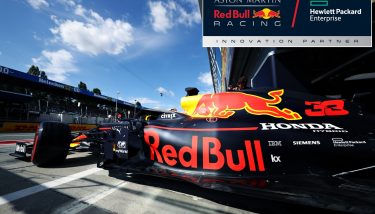The high-octane sport of Formula One is a 200mph race for continuous development.
For Aston Martin Red Bull Racing, that means executing more than 30,000 design and engineering changes a year – a feat made possible thanks to cutting-edge digital simulation and analytical tools.

In Formula One, winning is as much about decision-making as it is about having the best drivers and vehicle on the day.
Like manufacturers, Aston Martin Red Bull Racing’s ability to optimise and dynamically adapt their decision-making in real time is almost impossible without data.
Since the 2005 Formula One season, the UK-based Team has racked up 62 wins and four double world championships, in part thanks to its unwavering commitment to continuous improvement.
Data sits at the core of everything Aston Martin Red Bull Racing does, with every department and activity threaded together through what the Team refer to as their ‘digital backbone’.
This constant flow of information helps the Team accelerate its car development programme, as well as create feedback loops that capture what is happening, or has happened, on the racetrack and help drive continuous vehicle development throughout the course of a season.
One of the most crucial ‘vertebrae’ in this backbone are digital simulation tools, says Matt Cadieux, Chief Information Officer for Aston Martin Red Bull Racing.
Simulations
From its manufacturing base in Milton Keynes, the Team produce and procure upwards of one million parts a year – around 70% of which are manufactured in-house. The organisation employs more than 600 people to design, engineer, test, manufacture, assemble, inspect and maintain the tens of thousands of unique components in each of its cars.

Before any new component, sub-assembly, panel or complete vehicle reaches physical testing, or even the scale wind tunnel test, it is analysed and evaluated in virtual 3D by supercomputers.
Computational fluid dynamics (CFD) is a cost-effective and accurate means of analysing new CAD designs, refinements and ideas, simulating in great detail how air will flow around the structures and surfaces to evaluate whether the new iteration will help boost performance.
“Simulations and digital modelling play a huge role” in Aston Martin Red Bull Racing, explains Matt, from helping to inform the design and production of each vehicle, through to enabling the Team to make data-driven decisions at the track.
“As we iterate the design of the car for each race, we rely on CFD, but then continue our design-making through data from our driver simulator and then as we prepare for a race weekend run through race simulations to support decision-making by our strategy team. Simulations are really key to our continued success.”
“The business is always pushing us to provide more capability as we make greater use of simulations and analytics and as our models get larger and more complex. We also have significant cost and resource constraints,” Matt continues.
“We manage this by having the right infrastructure foundations in place, and we work with leading technology partners to implement a highly capable ecosystem. HPE is one of our key partners and one of the systems that they have implemented is an HPE Moonshot cluster for CFD. The Moonshot system gives us the performance, reliability and efficiency that we require to maximise CFD throughout in a cost-effective manner”.
“If we go back several years ago, simulations were seen as science projects. Now, simulations are viewed as vital, real-world tools that, in the hands of skilled engineers, allow us to perform at a higher level,” he concludes.
A ‘digital twin’

The attitude more traditional manufacturers exhibit towards digital simulations has followed a similar journey to that of the race team.
Take ‘digital twins’, for example. These virtual representations of physical products not only accelerate optimum outcomes by avoiding time-consuming verification and testing procedures, digital twins can also help improve real-time performance by augmenting them with artificial intelligence and predictive capabilities.
The global digital twin market is expected to achieve a CAGR of 35% between 2019 and 2024, according to Orbis Research; when it will surpass US$20bn, according to Market Study Report.
Formula One is a good example of “digitally-driven agility”, according to Jason Renders, Account Director, Global Industries, at Hewlett Packard Enterprise (HPE).
“Race teams are increasingly becoming DevOps businesses; organisations that have had to become more digitally-enabled through ever more stringent regulations and a corresponding reduction in the amount of time they had to innovate and test new designs.
“Many of the tasks that would have been laborious and time-consuming or based on the ‘gut feel’ of a senior engineer are now being automated or supported by simulations and analytics. That’s a transition many manufacturers have already been through or are currently working their way through.”
HPE Moonshot – a different kind of HPC server
High performance computing (HPC) brings the challenges of energy efficiency, cost, real-time responsiveness, and massive demand for processing power. Traditional server architecture is not always the complete answer.
HPE Moonshot’s unique integrated graphics processing unit (GPU), high-performance, and density make it a key piece in a complete HPC server architecture, particularly for enterprises with the need for massive processing power, such as manufacturing, the oil and gas industry, auto racing and research.
HPE’s massively parallel, high-density HPC servers help customers meet the cost, performance, and responsiveness demands of high-performance computing.
